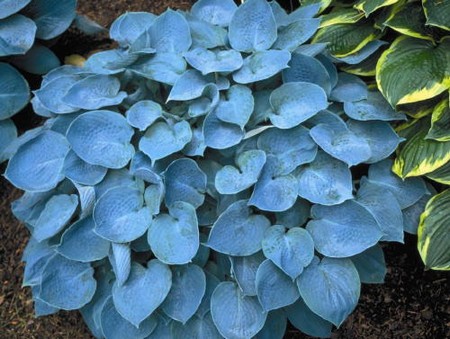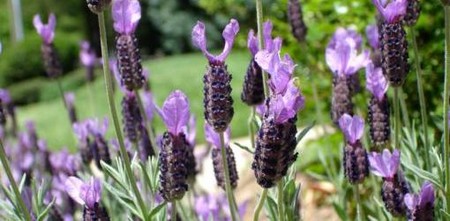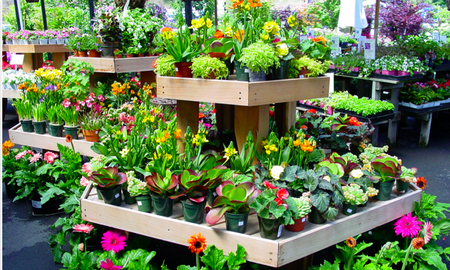Mail-order nurseries ship their plants in the way best calculated to get them to the customer in good condition, so they may be bare-root, potted, or dug and wrapped. Consider first the plants that are shipped bare-root. These are totally dormant and have been held in cold storage since they were dug. They don’t look too promising when you unpack them, these bare sticks, but the fact that the leaf buds have not opened is a plus—there will be no loss of moisture through the leaves. Many trees and shrubs, and quite a few perennials, especially roses, are shipped this way, and I’ve found that they grow well.
We’ll assume that you have prepared a place for your plants ahead of time.
For trees, it’s a good idea to prepare a hole the previous fall (if your plans are made that far ahead) to allow the soil to settle over the winter. You should unwrap the package as soon as you receive it and soak the roots in water for an hour or two before planting. Evening is the preferred time for planting out, or at least after sundown. It gives the plants a night to recover. If, however, you can’t plant that day, open the package and put it in a cool, dark place. It is not a good idea to soak roots any longer than the recommended time.
Now for the planting. Dig a generous hole, allowing width as well as depth. A common mistake is to make a deep, narrow hole. This puts the plant’s roots down in cold soil without opportunity for lateral growth. Put your compost in and make a mound or cone in the center of the hole. Rest the base of the plant on this and spread the roots out and down all around the cone.
We’ll take a rosebush for our example of bare-root planting. Hold the plant in one hand in such a way that when the hole is filled in the rose will be at the same level as it was before (you will usually see a line where the soil surface had been, but do read the instructions that come with the plants). Fill in with soil, firming it in between the roots with your fingers. If you find you’ve planted it too deeply, jiggle it up and down gently. If it seems to be too high, there’s nothing for it but to redig the hole.
Once you are satisfied that the plant is at the right height, push the soil in around the roots and tamp down firmly. With a good-sized plant, you can use your feet. The “saucer” around the plant should be an inch or two lower than the surrounding soil so that the soil won’t wash away when you water the plant.
Now stand back and look at the plant. Is it straight? Does it show its best face forward? At this stage—before it’s been watered—you can still move the plant very easily. When you’re satisfied with the position of the plant, it’s time to water it in.
I like to use a hose to water because it supplies more force; this is not a time for gentle watering. The purpose is to force the soil down around the roots, leaving no air pockets, so direct a stream of water down around the plant. Once you have watered, do not tamp anymore or you will compress the wet soil. Permit the planting to drain completely and draw loose soil in over the surface. If it’s still early in the spring, it’s a good idea to hill the plant up slightly with loose soil or whatever mulch you have at hand. I use pine needles because they are airy (and because we have so many of them).
There’s no need to prune rosebushes at this stage. Pruning will have been done at the nursery, but do remove any label that’s wired onto the stem, or it will damage the plant as it grows.
Don’t despair if nothing happens for a few weeks. When the leaf buds do “break,” the whole plant will take off like a rocket. One year, I waited all through May—no sign of life; all through June—no sign of life. Came July, and the rose burst into leaf and then bloomed.
Mail-order nurseries also ship plants that are neither bare-root nor potted. These plants are at considerable risk because they are not dormant. They have been dug and interrupted in their growth. Nurseries must exercise the greatest care in packing them. I’ve received boxes of plants from the best—each plant, its roots holding a little ball of soil or planting mix, wrapped in damp newspaper, a name label attached, and the whole held tightly in two rubber bands. Lying on their side in a strong mailing carton, they are packed in wood shavings and the leafy tops are separated by pieces of rigid cardboard. Interestingly enough, these are not necessarily from nurseries with the highest prices. Once safely received these plants will ask more of you, also.
If such nondormant plants arrive before it is safe to plant them outside, you may have to pot them up yourself. I hate to do this because it’s one more job in a busy spring, but it will hold them until you can get them into the ground. Use a good planting mix such as ProGro. This commercial soilless mix is made up of roughly equal parts of peat moss and vermiculite. It holds moisture well and is sterile. Water the pots lightly and set them in a cool, shady place; after several days in a cardboard carton they cannot be expected to withstand wind or hot sun. Don’t worry if some of the older leaves yellow and die; the plant will be making new leaves. Feed with a weak solution of soluble fertilizer when you put them out into the garden.
Mail-order plants that come in pots will generally be in good shape and can be left outside in their pots for a week or more until you are ready to plant them, but you must check daily to see if they need water.
Your job will be to make a smooth transition from pot to open ground. Take a plant, tip it out of its pot and see how the roots are growing. If they are clumped together, separate them. If they are long and wound around the root ball, clip some of them off. If it looks as if the plant has been in that pot for a considerable time, make several cuts with a knife down the sides of the root ball. The planting procedure will be the same as for bare-root stock but, since these plants have leaves and could lose moisture through transpiration, you should provide some shade for them.
With all these planting procedures, one hopes for a calm and cloudy day, but sometimes you can wait no longer and have to risk planting under less than ideal conditions. No matter what type of plant you ordered, you should have the catalog at hand for reference. Nurseries are putting out better and better cultural notes with their plant orders, and you might as well read the instructions without waiting for the “if all else fails” part.
Categories
Advertisements
Recent Articles
 How to Understand Bed Sizes – A Small Guide
How to Understand Bed Sizes – A Small Guide How to Select Some Must Have Kitchen Accessories
How to Select Some Must Have Kitchen Accessories Best Way to Change a Car Tire
Best Way to Change a Car Tire Best Way to Write an Affirmation
Best Way to Write an Affirmation Best Way to Take Charge of Your Financial Life
Best Way to Take Charge of Your Financial Life Best Way to Survive a Party When You Don’t Know Anyone
Best Way to Survive a Party When You Don’t Know Anyone Best Way to Stop Self Sabotaging Yourself
Best Way to Stop Self Sabotaging Yourself Best Way to Start Journal Writing
Best Way to Start Journal Writing Best Way to Speak with a Powerful Voice
Best Way to Speak with a Powerful Voice Best Way to Simplify Your Life
Best Way to Simplify Your Life Best Way to Respond to a Put-Down
Best Way to Respond to a Put-Down Best Way to Reduce Acne Breakouts
Best Way to Reduce Acne Breakouts Best Way to Recover from Dining Disasters
Best Way to Recover from Dining Disasters Best Way to Quit Your Job Gracefully
Best Way to Quit Your Job Gracefully Best Way to Make Your Own Website
Best Way to Make Your Own Website




Leave a Reply